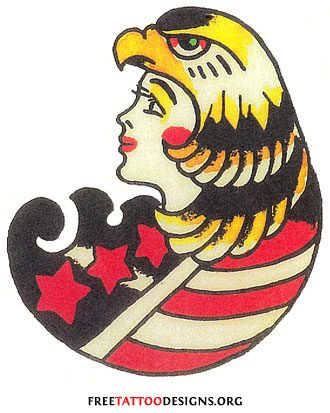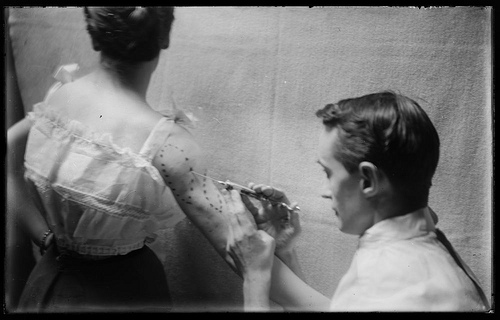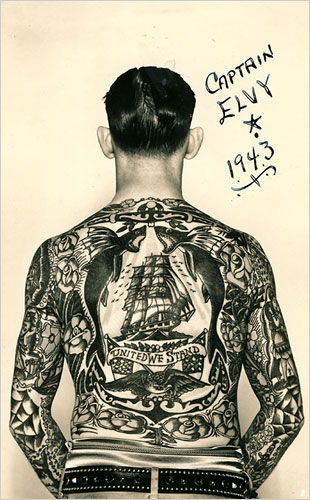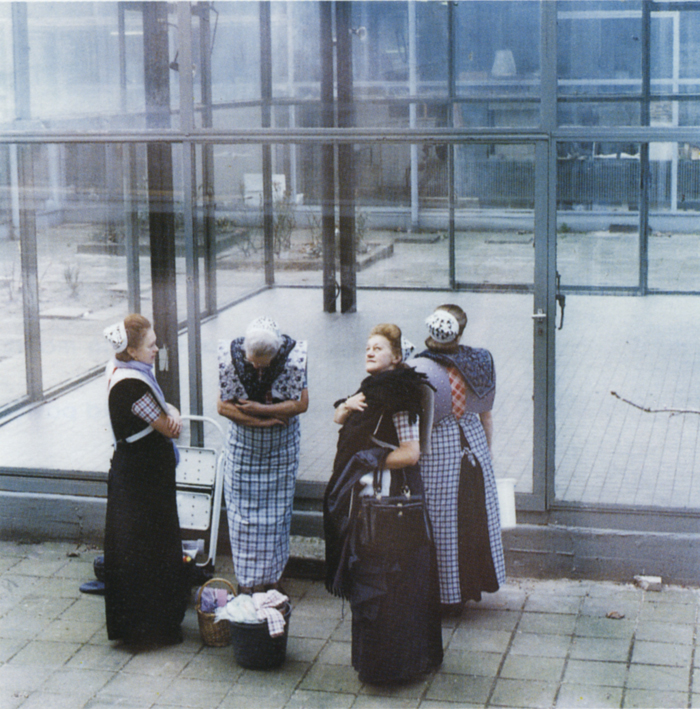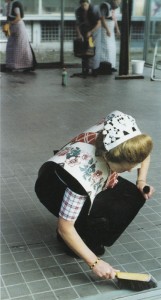Old school sailors
My class-mate Olga makes beautiful old school tattoos with markers and colorful felt-pens. Maybe for her graphic hand or maybe because she was for a year on a sailing ship, the Falcon.
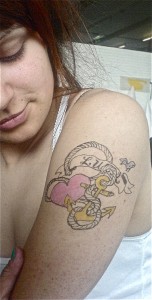
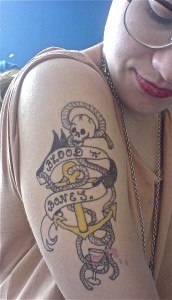
Roses, sacred hearts, daggers and anchors are her favorite subjects, exactly like the Old School style tells. Black lines draw easy and round figures that have to be filled with solid colors. Thanks to the sailors coming from exotic places (like the Philippines where Olga’s family come from) during the XVIII and XIX centuries who had contact with different tattoo arts and cultures. For sailors tattoos were a sign to remember adventures and reason to tell stories. In the beginning of ‘900 the tattoo practice started to arrive in the western important ports with the same sailors were opening small tattoos studios. Sailor Jerry (1911-1973) is the initiator of the style in Honolulu
in a notoriously neighborhood, frequented by the best names in prostitution and crime and, as always, by the well sailors. What shock me most of the Old Style is the elastic feature in design that from aggressive and poetic can become sensual and delicate. In the western society it easily changes attitude being used also from elegant women in visible and provocative places, maybe trying to imitate the sensual free body language of the same sex over ocean.
picture of William Vander Weyde, (1871-1929)
From my researches one of the first country that adopted tattoos was England, from the sailing in Polynesia, in the middle 18th Captain Samuel Wallis, French explorer, was one of the first to write about tattoos: “universal custom among men and women to get their buttocks and the back of their thighs painted with thin black lines representing different figures”.
The polynesian women were having their first tattoo at the age of 12. From that point tattoos were defining roles, position in society and head also religious meaning. The design of Polynesian tattoos was a Tribal style: geometric forms and stylization from natural element. It was really different from what we know about the Old School style of the sailors. I didn’t understand exactly what was the western approach to the indigenous culture in the case of tattoos and what european people kept from it. I think they were really fascinated by the act, painful and beautiful at the same
time. Looking at pictures 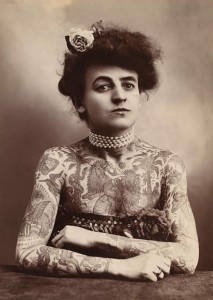 of european and american women full of tattoos at the beginning of the 1900, i was thinking about their role in society, how was possible at the time of the “belle époque” to look like a polynesian? I didn’t find a lot, but in one of the most famous example there’s Nora, daughter of Martin Hildebrandt who in 1846 opens the first U.S. tattoo shop in New York City, servicing from both sides of the Civil War. Nora, rises to fame in the 1890s when she tours with the Barnum and Bailey Circus as the Tattooed Lady.
of european and american women full of tattoos at the beginning of the 1900, i was thinking about their role in society, how was possible at the time of the “belle époque” to look like a polynesian? I didn’t find a lot, but in one of the most famous example there’s Nora, daughter of Martin Hildebrandt who in 1846 opens the first U.S. tattoo shop in New York City, servicing from both sides of the Civil War. Nora, rises to fame in the 1890s when she tours with the Barnum and Bailey Circus as the Tattooed Lady.
[by Sara Cattin]
Never on a Friday
Not a gem of the Amsterdamse School, the HMS Falken nevertheless originates in Dutch craftsmanship as a ‘Schoener’ first set afloat in 1947 and still sails the Seven Seas. The term or idea of the Seven Seas was coined as early as 2300 BC, but as many myths and legends at sea, the stories change. However, they do survive. Some might not think that brave and adventurous men at sea waste their time and occupy their minds with silly stories and folklore but more so than anything else – that’s exactly what they do. Sailors are without doubt the most superstitious people I’ve ever met. Among loads of quirky habits and traditions, these are a few does and don’ts you should consider when embarking a ship:
- Don’t put your left foot down first when going aboard.
- Sail out on a Sunday when leaving the port, never on a Friday.
- If you meet a priest, a redhead or women without shoes on your way to the ship – stay at home for the rest of the day, don’t leave the port.
- Keep a black cat on board for good luck; all other black items are banned.
- Don’t kill any birds if you run out of food at sea. Especially not an albatross. Birds will bring you to land, but most important; albatrosses carries the souls of dead sailors.
- Do keep your eyes open for nude women; it’s good luck. That’s also why the figurehead in the bow of the ship often is a female (with one breast bare in good taste).
- Wear earrings, they will enhance your eyesight. Sailors ought to wear a golden earring in case they’ll drown and get found ashore because it will finance their funeral.
- Don’t light a cigarette or pipe on a candle, if the candle blows out you’re doomed.
- Don’t whistle. Whistling resembles the wind in the sails and will for sure call upon the storm.
Keep this in mind and you’ll likely go along with the skipper.
Anne Bonny & Mary Read [x]
[by Olga Nordwall]


